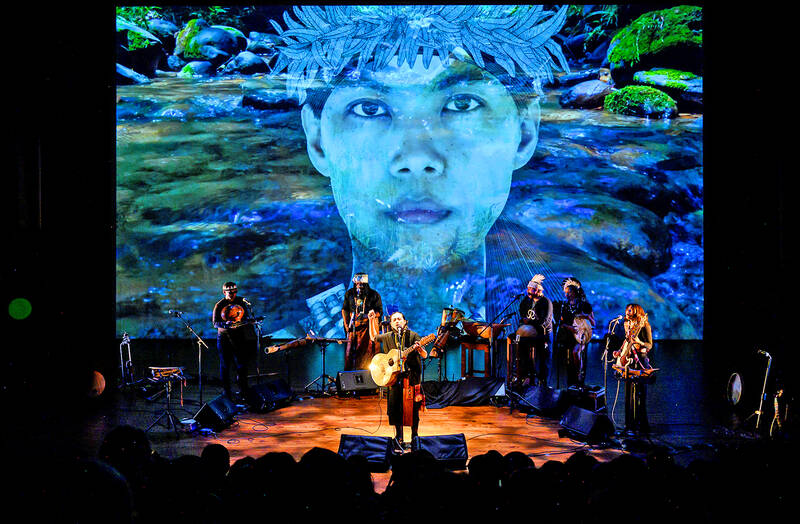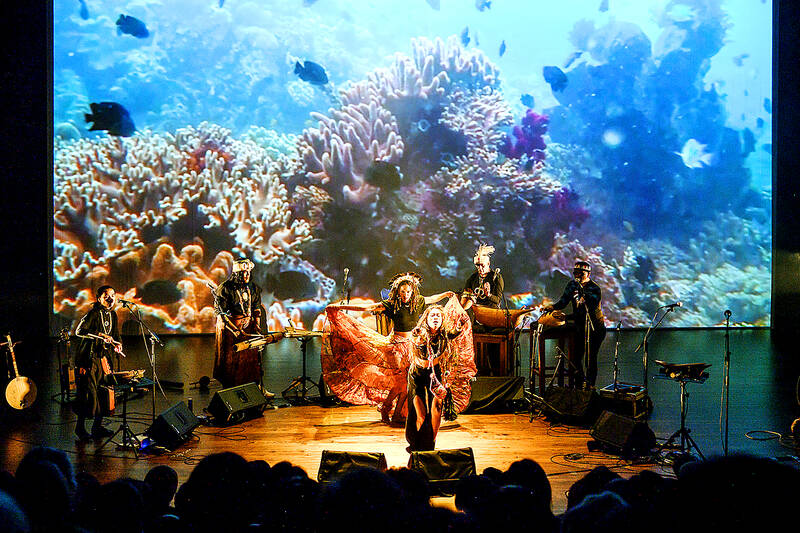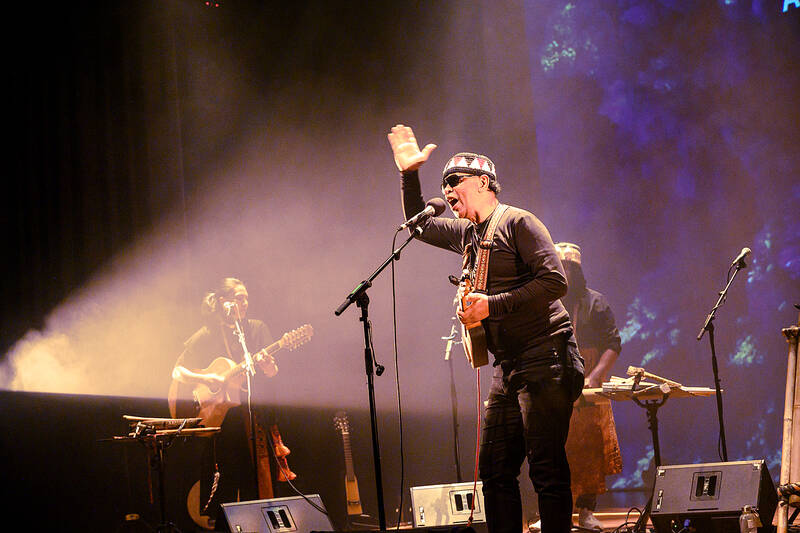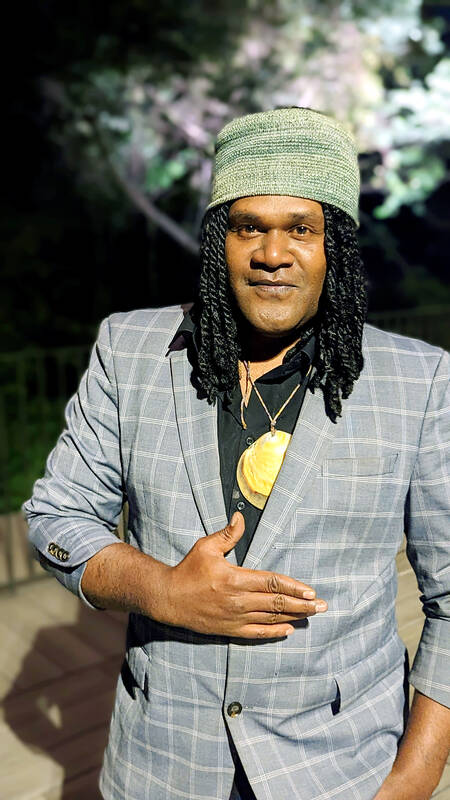After collaborating online for nearly a year, Sauljalui could not wait to meet the other musicians, who hailed from islands across the Pacific and Indian oceans.
But she had to wait outside the residence and rehearsal space in Vashon Island near Seattle, in frigid January temperatures, for all members of the Small Island, Big Song (小島大歌, SIBS) project to clear their PCR tests.
“Once they announced that it was safe, we rushed in and hugged each other,” Sauljalui, who hails from the Paiwan indigenous community, tells the Taipei Times. “We began singing, dancing and talking about what each person played on which song.”

Photo courtesy of Hank Tsai
They jammed for hours, and for days afterward before kicking off a four-month tour of the US and Europe to promote SIBS’s latest album, Our Island. They were meant to record it together in person, but the COVID-19 pandemic dashed those plans. On Tuesday, the group concluded their Taiwan tour at Cloud Gate Theater, which was a homecoming of sorts as their ancestors largely originated in Taiwan and spread as far as Madagascar, Rapa Nui and New Zealand through the Austronesian expansion.
“We chose Cloud Gate for the final performance because they brought Taiwan’s artistry to the world,” SIBS co-founder Baobao Chen (陳玟臻) says. “There’s a lot of our culture and stories that the world has yet to see, and an important element is the Austronesian story.”
After unexpectedly learning about Taiwan’s role in Austronesian history in 2012, Chen and her husband, music producer and filmmaker Tim Cole, have spent the past eight years traveling these islands and working with local musicians who use traditional instruments and sing in their native languages.

Photo: Han Cheung, Taipei Times
Despite the ancestral connections, the main message of the show was environmental protection, as these islands are especially vulnerable to climate change. Each musician presented a song about the problems they face. Sauljalui explored the flooding of her ancestral lands by the Mudan Reservoir (牡丹水庫) in Pingtung County’s Mudan Township (牡丹) and rising sea levels in the Marshall Islands, Emyln Lamizik from Mauritius highlighted a serious 2020 oil spill and Sammy Andriamalalaharijaona from Madagascar pleaded for people to stop cutting down the rainforest.
“If artists want to sing about love, that’s okay, but I want to sing about climate change,” Andriamalalaharijaona tells the Taipei Times. “We must be responsible and tell people every day to respect [nature], otherwise one day you’ll have nothing left in this world.”
INEXPLICABLE CONNECTION

Photo courtesy of Hank Tsai
The musicians all speak of an inexplicable connection, as highlighted in “Eight Islands, One Voice” (Oct. 2, 2021, Taipei Times) by Amis musician Putad Pihay.
Andriamalalaharijaona visited Taiwan 15 years ago, but this time he was able to spend time with Putad and Sauljalui’s people.
“I feel like it’s the same culture, and sometimes it’s the same face,” he says. “Sauljalui looks like my sister. I was very surprised.”

Photo courtesy of Hank Tsai
Sauljalui also found many similarities, from their history to language to material culture. During their regular Zoom sessions while creating the album, they shared stories about their daily life and customs in addition to music.
“We use local materials to make instruments and necklaces, and we talked a lot about our rituals and how we try to coexist with the ocean, the mountains and educate [our descendants],” she says.
Richard Mogu from Papua New Guinea was delighted at the chance to finally visit Taiwan.

Photo: Han Cheung, Taipei Times
“I really wanted to see Sauljalui and Putad’s place and we really wanted to meet each other again,” he says. “There’s an important message to put out there, but it’s also about the musical vibe. Even if we don’t speak the same language, it’s like meeting our family who’s living abroad. We can feel each other’s spirit without explaining it.”
Sauljalui says that one of the driving forces that sustains the project is the strong cultural background, knowledge and beliefs that each musician carries.
“We don’t have to try to figure out who we need to be,” she says. “When you see the others being true to who they are, it lifts up your cultural confidence too.”

Photo: Han Cheung, Taipei Times
Charles Maimarosia from the Solomon Islands says the world needs to be connected even beyond the Austronesian family.
“We really need to set a foundation for future generations to be closer than this one, whether it be through music or anything,” he says.
FOR THE ENVIRONMENT
Growing up in the mountain village of Kapanan in Pingtung County, Sauljalui wondered at first how she could connect with the maritime-based cultures of the other musicians. She was told at a young age that the ocean was dangerous.
She thought of how poet Selina Leem from the Marshall Islands spoke of her homeland being submerged by rising sea levels, and linked it to how the Mudan Reservoir drowned most of her people’s traditional lands in 1995 and greatly affected the environment.
“When we were young, we swam and caught fish in the river downstream,” she says. “We learned from nature. But today, our village is cut off from the river. The children don’t know how to swim. If they want to learn, they have to take a bus to a swimming pool in Hengchun (恆春) and pay NT$50 to get in.”
Her song Madjajumak, a collaboration with Meem and other musicians, was conceived during a recent drought.
“I imagined myself as a dry river … and when the rain comes, I just want to flow to the ocean, to the Marshall Islands, Madagascar, Rapa Nui, to anywhere,” she says. “In this song, I say, please listen to my tears and let it rain so I can go to those places. It combines personal emotions and the loss of nature.”
Maimarosia says he wants to speak for the living beings and environment that are being destroyed.
“My voice is not the best, but I do believe that my little voice for the fish and the coral in the ocean makes sense now and in the future as well,” he says.
His song, Naka Wara Wara To’o, talks about how people need to stop overharvesting to preserve the natural cycle of life in the ocean.
“Everything depends on each other,” he says.
Mogu says the atoll he hails from is also suffering from rising sea levels.
“The beaches we used to play on are becoming [smaller], and the wells we used to drink fresh water from are becoming salty,” he says. “Often, we can’t plant our food, and we have to go to the mainland. We need to sound the alarm more. I want to write about topics that affect the livelihood of my children.”

June 2 to June 8 Taiwan’s woodcutters believe that if they see even one speck of red in their cooked rice, no matter how small, an accident is going to happen. Peng Chin-tian (彭錦田) swears that this has proven to be true at every stop during his decades-long career in the logging industry. Along with mining, timber harvesting was once considered the most dangerous profession in Taiwan. Not only were mishaps common during all stages of processing, it was difficult to transport the injured to get medical treatment. Many died during the arduous journey. Peng recounts some of his accidents in

A short walk beneath the dense Amazon canopy, the forest abruptly opens up. Fallen logs are rotting, the trees grow sparser and the temperature rises in places sunlight hits the ground. This is what 24 years of severe drought looks like in the world’s largest rainforest. But this patch of degraded forest, about the size of a soccer field, is a scientific experiment. Launched in 2000 by Brazilian and British scientists, Esecaflor — short for “Forest Drought Study Project” in Portuguese — set out to simulate a future in which the changing climate could deplete the Amazon of rainfall. It is

What does the Taiwan People’s Party (TPP) in the Huang Kuo-chang (黃國昌) era stand for? What sets it apart from their allies, the Chinese Nationalist Party (KMT)? With some shifts in tone and emphasis, the KMT’s stances have not changed significantly since the late 2000s and the era of former president Ma Ying-jeou (馬英九). The Democratic Progressive Party’s (DPP) current platform formed in the mid-2010s under the guidance of Tsai Ing-wen (蔡英文), and current President William Lai (賴清德) campaigned on continuity. Though their ideological stances may be a bit stale, they have the advantage of being broadly understood by the voters.

Artifacts found at archeological sites in France and Spain along the Bay of Biscay shoreline show that humans have been crafting tools from whale bones since more than 20,000 years ago, illustrating anew the resourcefulness of prehistoric people. The tools, primarily hunting implements such as projectile points, were fashioned from the bones of at least five species of large whales, the researchers said. Bones from sperm whales were the most abundant, followed by fin whales, gray whales, right or bowhead whales — two species indistinguishable with the analytical method used in the study — and blue whales. With seafaring capabilities by humans